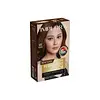What's inside
What's inside
 Key Ingredients
Key Ingredients

 Benefits
Benefits

No benefits
 Concerns
Concerns

 Ingredients Side-by-side
Ingredients Side-by-side

Water
Skin ConditioningCetearyl Alcohol
EmollientHydrogen Peroxide
AntimicrobialCeteareth-33
CleansingPhosphoric Acid
BufferingOxyquinoline Sulfate
AntimicrobialEthanolamine
BufferingPropylene Glycol
HumectantCeteareth-25
CleansingCeteth-2
EmulsifyingPEG-2 Rapeseedamine
Toluene-2,5-Diamine Sulfate
PEG-4 Rapeseedamide
Oxidized Corn Oil
Skin Conditioning2-Methylresorcinol
Simmondsia Chinensis Seed Oil
EmollientSodium Sulfite
PreservativeCocos Nucifera Oil
MaskingPropanediol
SolventFrangula Alnus Bark Extract
Skin ConditioningParfum
MaskingMaltodextrin
Absorbent4-Chlororesorcinol
Rubia Tinctorum Root Extract
Skin ConditioningPolyquaternium-22
Ascorbic Acid
AntioxidantSodium Hydrosulfite
Tetrasodium EDTA
Haematoxylum Campechianum Wood Extract
Cosmetic Colorant2-Amino-4-Hydroxyethylaminoanisole Sulfate
Genista Tinctoria Flower/Leaf/Stem Extract
Skin ConditioningCoreopsis Tinctoria Flower/Leaf/Stem Extract
Skin ConditioningM-Aminophenol
Ziziphus Joazeiro Bark Extract
Skin ConditioningGardenia Taitensis Flower
Skin ConditioningOctadecyl Di-T-Butyl-4-Hydroxyhydrocinnamate
AntioxidantP-Aminophenol
Phenyl Methyl Pyrazolone
Tocopherol
AntioxidantCetyl Alcohol
EmollientBehentrimonium Chloride
PreservativePhenoxyethanol
PreservativePongamia Glabra Seed Oil
Skin ConditioningEthyl Macadamiate
Skin ConditioningCetrimonium Chloride
AntimicrobialHydroxyethylcellulose
Emulsion StabilisingChlorphenesin
AntimicrobialHydrolyzed Pea Protein
EmollientPolyquaternium-53
Hibiscus Sabdariffa Flower Extract
Skin ConditioningGlycerin
HumectantCaesalpinia Spinosa Fruit Extract
Skin ProtectingCitric Acid
BufferingDisodium Phosphate
BufferingPotassium Sorbate
PreservativeSodium Phosphate
BufferingPolysorbate 60
EmulsifyingHelianthus Annuus Sprout Extract
Skin ConditioningSodium Benzoate
MaskingMalic Acid
BufferingLimonene
PerfumingLinalool
PerfumingHexyl Cinnamal
PerfumingWater, Cetearyl Alcohol, Hydrogen Peroxide, Ceteareth-33, Phosphoric Acid, Oxyquinoline Sulfate, Ethanolamine, Propylene Glycol, Ceteareth-25, Ceteth-2, PEG-2 Rapeseedamine, Toluene-2,5-Diamine Sulfate, PEG-4 Rapeseedamide, Oxidized Corn Oil, 2-Methylresorcinol, Simmondsia Chinensis Seed Oil, Sodium Sulfite, Cocos Nucifera Oil, Propanediol, Frangula Alnus Bark Extract, Parfum, Maltodextrin, 4-Chlororesorcinol, Rubia Tinctorum Root Extract, Polyquaternium-22, Ascorbic Acid, Sodium Hydrosulfite, Tetrasodium EDTA, Haematoxylum Campechianum Wood Extract, 2-Amino-4-Hydroxyethylaminoanisole Sulfate, Genista Tinctoria Flower/Leaf/Stem Extract, Coreopsis Tinctoria Flower/Leaf/Stem Extract, M-Aminophenol, Ziziphus Joazeiro Bark Extract, Gardenia Taitensis Flower, Octadecyl Di-T-Butyl-4-Hydroxyhydrocinnamate, P-Aminophenol, Phenyl Methyl Pyrazolone, Tocopherol, Cetyl Alcohol, Behentrimonium Chloride, Phenoxyethanol, Pongamia Glabra Seed Oil, Ethyl Macadamiate, Cetrimonium Chloride, Hydroxyethylcellulose, Chlorphenesin, Hydrolyzed Pea Protein, Polyquaternium-53, Hibiscus Sabdariffa Flower Extract, Glycerin, Caesalpinia Spinosa Fruit Extract, Citric Acid, Disodium Phosphate, Potassium Sorbate, Sodium Phosphate, Polysorbate 60, Helianthus Annuus Sprout Extract, Sodium Benzoate, Malic Acid, Limonene, Linalool, Hexyl Cinnamal
Alternatives
Ingredients Explained
These ingredients are found in both products.
Ingredients higher up in an ingredient list are typically present in a larger amount.
Cetearyl alcohol is a mixture of two fatty alcohols: cetyl alcohol and stearyl alcohol. It is mainly used as an emulsifier. Emulsifiers help prevent the separation of oils and products. Due to its composition, it can also be used to thicken a product or help create foam.
Cetearyl alcohol is an emollient. Emollients help soothe and hydrate the skin by trapping moisture.
Studies show Cetearyl alcohol is non-toxic and non-irritating. The FDA allows products labeled "alcohol-free" to have fatty alcohols.
This ingredient is usually derived from plant oils such as palm, vegetable, or coconut oils. There is debate on whether this ingredient will cause acne.
Due to the fatty acid base, this ingredient may not be Malassezia folliculitis safe.
Learn more about Cetearyl AlcoholDisodium Phosphate is a water-soluble powder used as a pH adjuster.
We don't have a description for Hydrogen Peroxide yet.
Parfum is a catch-all term for an ingredient or more that is used to give a scent to products.
Also called "fragrance", this ingredient can be a blend of hundreds of chemicals or plant oils. This means every product with "fragrance" or "parfum" in the ingredients list is a different mixture.
For instance, Habanolide is a proprietary trade name for a specific aroma chemical. When used as a fragrance ingredient in cosmetics, most aroma chemicals fall under the broad labeling category of “FRAGRANCE” or “PARFUM” according to EU and US regulations.
The term 'parfum' or 'fragrance' is not regulated in many countries. In many cases, it is up to the brand to define this term.
For instance, many brands choose to label themselves as "fragrance-free" because they are not using synthetic fragrances. However, their products may still contain ingredients such as essential oils that are considered a fragrance by INCI standards.
One example is Calendula flower extract. Calendula is an essential oil that still imparts a scent or 'fragrance'.
Depending on the blend, the ingredients in the mixture can cause allergies and sensitivities on the skin. Some ingredients that are known EU allergens include linalool and citronellol.
Parfum can also be used to mask or cover an unpleasant scent.
The bottom line is: not all fragrances/parfum/ingredients are created equally. If you are worried about fragrances, we recommend taking a closer look at an ingredient. And of course, we always recommend speaking with a professional.
Learn more about Parfum